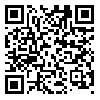Volume 58, Issue 3 (7 2000)
Tehran Univ Med J 2000, 58(3): 29-34 |
Back to browse issues page
Download citation:
BibTeX | RIS | EndNote | Medlars | ProCite | Reference Manager | RefWorks
Send citation to:



BibTeX | RIS | EndNote | Medlars | ProCite | Reference Manager | RefWorks
Send citation to:
Nili F. High frequency oscillatory ventilation in severe respiratory failure. Tehran Univ Med J 2000; 58 (3) :29-34
URL: http://tumj.tums.ac.ir/article-1-1384-en.html
URL: http://tumj.tums.ac.ir/article-1-1384-en.html
Abstract: (7514 Views)
Despite improvement of mechanical ventilation devices for infants, lung injury still causes morbidity and mortality in many cases. To determine the effect of high frequency oscillatory ventilation (HFOV) in infants with severe respiratory failure, 10 neonates were evaluated prospectively. Mean gestational age of these patients was 35 weeks and alveolar-arterial oxygen gradient (A-aDo2) and the ratio of arterial to alveolar oxygen pressure (a/A) immediately before HFO were 610 torr and 0.072 respectively. These neonates were received inspired oxygen concentration of >95% with a mean airway pressure of 12 cm H2O by conventional mechanical ventilation. The A-aDo2 and a/A after 6 and 24 hrs on HFO was not significant in those infants with survived compared with those who died. Comparison of 3 alive neonates with 7 deaths, demonstrate that pulmonary hypoplasia, HMD accompanied with asphyxia, congestive heart failure with pneumonia are associated with poor outcome. The mean a/A ratio during 24hrs of HFO in the alived HMD group was 0.75 compared with 0.25 in those who died. It is possible that we can use this as a prognostic factor in survival. In this study, the positive effect of HFOV was demonstrated in those with no predisposing factors such as pulmonary hypoplasia, congestive heart failure, pneumonia and asphyxia.
| Rights and permissions | |
 |
This work is licensed under a Creative Commons Attribution-NonCommercial 4.0 International License. |





